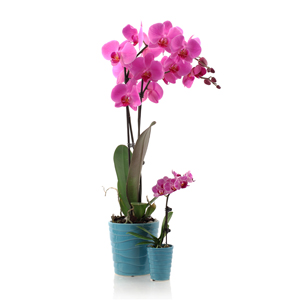
Phalaenopsis orchids are notoriously easy to care for. But whether you’ve just received one, or you’ve been caring for them for years, some common orchid care questions usually send people to the nearest search engine looking for advice.
Close that Google tab because our expert team of growers has answered some of your most pressing questions about phalaenopsis orchid care. Here are the top four frequently asked questions.
It can be a surprise to see your orchid rebloom with less flowers than it had when you first brought it home. But don’t despair. Chances are your orchid care routine is just fine. Your orchid has a few less blooms because your home environment doesn’t have the ideal humidity and temperature of the greenhouse where your plant originated.
It’s OK if your orchid’s air roots have turned yellow or have become dry. This is often the case if the environment where you keep your orchid has low humidity. Though they can look unpleasant, dried air roots won’t hurt your orchid. You can try increasing humidity by creating a humidity tray, or when your orchid has stopped blooming, you can remove the shriveled air roots with a sterile knife or pair of scissors.
Wrinkly leaves are a sign of dehydration, but before you make this diagnosis, check the orchid’s roots as well. If your orchid needs more water, its roots will look gray or white. Healthy roots are plump and green. Give your orchid some extra water by soaking its roots and bark in a bucket of water for two minutes. You can keep your orchid in its clear growing pot to soak it—just make sure the excess water has drained from the clear growing pot before placing it back into its decorative container.
Wait until your orchid has finished blooming to repot it. Repotting your orchid while it’s in bloom can result in bloom loss. The yellow leaves at the bottom of the plant are probably the result of the orchid trying to discard the mature leaves and produce new ones.
Keep these tips in mind when caring for your orchid—they will make your care routine smoother and might even save you a trip to Google. But if you still haven’t found the answer you’re looking for, take a look at these other frequently asked orchid care questions.

Copyright Just Add Ice® Orchids 2023